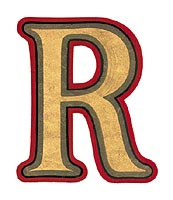Oil Gilding
Oil gilding disperses reflected light and therefore appears lighter than
water gilding from certain angles. It is done with a varnish or an oil-based
goldsize (oil/resin) that will dry gradually and develop a tacky surface.
The gold leaf is simply pressed onto the goldsize and it adhears to the tacky
surface. 
This method is used to achieve the matt centre seen in traditional lettering. It is used in emulation of acid etching.
Usually transfer leaf is used this way. It is easier to handle with less wastage and bright lustre is not critical. When oil gilding on a surface, the size is usually left tacky as long as possible without actually drying to achieve the best burnish. On glass it not so critical as the intention is to achieve a matt finish.
The varnish is sometimes left to dry and then water gilded over with plain gold leaf. This gives more of a satin appearance than direct oil gilding, both of which are useful finishes. It should not be left to fully cure though as this can result in an undesirable, streaky, uneven satin finish.
Oil size must be applied evenly without misses or overworking to achieve a smooth finish as it readily shows any blemishes or faults. Trying to repair a damaged section or missed spot will show and it is better to clean the varnish off and start over again.
The common metals (copper, schlag, variegated), being heavier than gold, are often oil gilded. One note of caution however, silver leaf shouldn't be oil gilded unless you want it to turn brown in a few months. The oil size/varnish tarnishes silver.
The goldsize/varnish is sometimes textured for a variation by working the goldsize with a tool. Another related techniques is tinting the goldsize. This is very similar to normal oil gilding and always results in a satin/matt finish but with a different hue. Expanding this to multiple layers is described in the section on color glazes .



